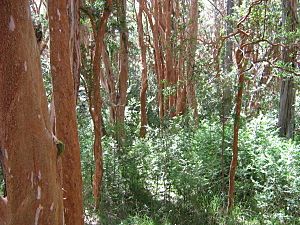Chilean myrtle facts for kids
Quick facts for kids Chilean myrtle |
|
|---|---|
 |
|
| Luma apiculata forest, in Los Arrayanes National Park, Argentina | |
| Scientific classification | |
| Genus: |
Luma (plant)
|
| Species: |
apiculata
|
| Synonyms | |
|
List
|
|
The Chilean myrtle, also known as Luma apiculata or temu, is a beautiful flowering plant. It belongs to the myrtle family. This tree is native to the central Andes mountains. You can find it in Chile and Argentina. It grows between 33 and 45 degrees south latitude. This tree can grow up to 10 to 15 meters (about 33 to 49 feet) tall and wide. It is a strong, bushy, evergreen tree. Its flowers smell very nice.
Contents
What it Looks Like
The Chilean myrtle grows slowly. It usually forms a small tree, about 10 to 15 meters tall. Sometimes it can reach 20 meters. Its trunk often looks twisted and bent. The bark is smooth and has a unique color. It ranges from gray to bright orange-brown. As the tree grows, its bark peels off. This makes the trunk look two-toned. You can see rich cinnamon colors mixed with creamy patches.
The tree is evergreen, meaning it keeps its leaves all year. Its small, oval leaves are fragrant. They are about 2.0 to 2.5 cm long and 1.5 cm wide. In early to midsummer, many white flowers bloom. The tree also produces an edible berry. These berries are black or blue. They are about 1.0 cm across and ripen in early autumn.
Names and Other Names
The Chilean myrtle has several scientific names. These are called synonyms. Some of its synonyms include Eugenia apiculata and Myrceugenia apiculata.
It also has many common names. In Spanish, it's called arrayán. This name comes from a European myrtle. The Mapuche Native American people call it kelümamüll. This means 'orange-wood' because of its bark color. Other names are shortleaf stopper, palo colorado, and temu.
Where the Name Comes From
The name Luma comes from a local Chilean name for this tree. The word apiculata means 'with a small, broadly pointed tip'. This describes the shape of its leaves.
Where it Lives
The Chilean myrtle likes to grow near water. You can find it along rivers and streams. It thrives in the Valdivian temperate rain forests in Chile. In Argentina, it grows from Neuquén south to the Chubut River.
Some of the most famous forests are in Argentina. They are on the Quetrihué Peninsula and Isla Victoria. These areas are part of the Los Arrayanes National Park and Nahuel Huapí National Park. The name Quetrihué means 'myrtles' in the Mapuche language. You can also find smaller groups of these trees along the Arrayanes River. This is in Los Alerces National Park. Some trees in these protected areas are very old, up to 650 years! The myrtle forest in Los Arrayanes National Park is special. It covers 20 hectares (about 49 acres). The cinnamon-colored myrtles grow so close together that few other trees can fit.
How People Use It
The fruit of the Chilean myrtle is popular in Chile and Argentina. People enjoy eating these berries. The flowers are also very important for making honey.
The Mapuche people use the Chilean myrtle for medicinal uses. It is also grown as a bonsai tree. Many people plant it in their gardens. They love the contrast between its shiny green leaves and its slender red stems.
This tree has started to grow on its own in parts of Ireland and western Great Britain. It has also been planted in Spain. Experts think it might be growing wild in New Zealand and the Pacific Northwest of the United States too.
The Chilean myrtle has received an Award of Garden Merit from the Royal Horticultural Society. This award means it is an excellent plant for gardens.
Gallery
See also
 In Spanish: Luma apiculata para niños
In Spanish: Luma apiculata para niños





